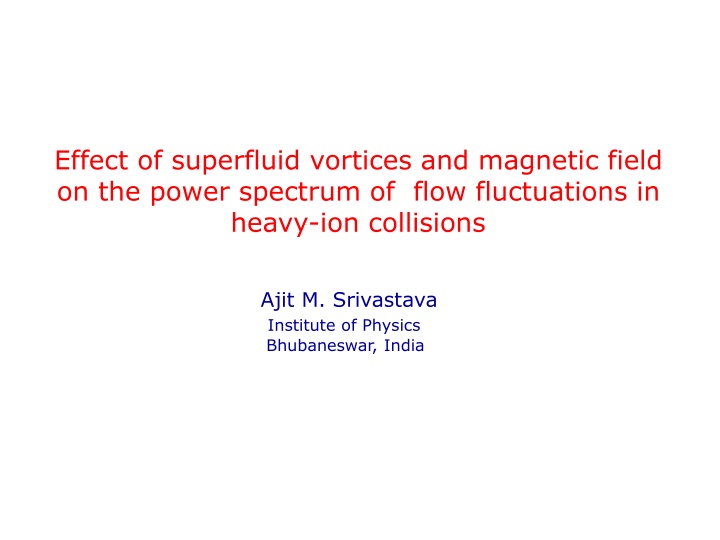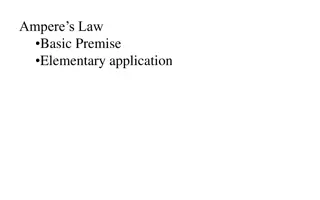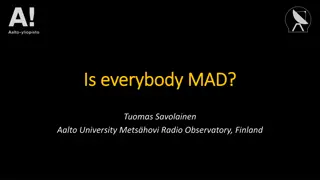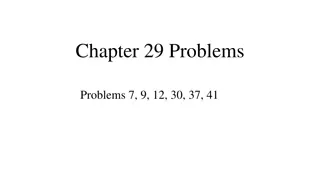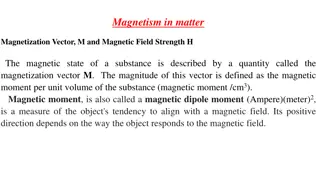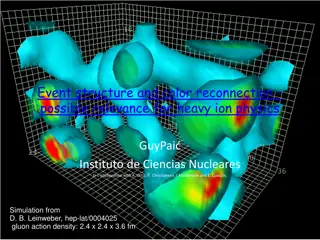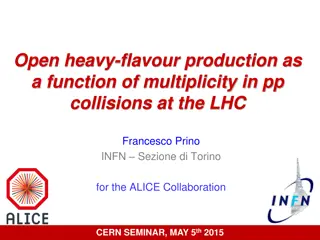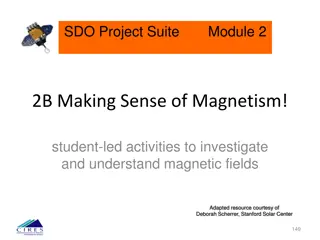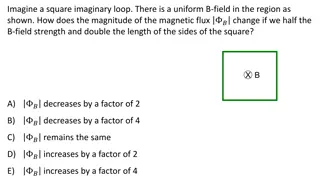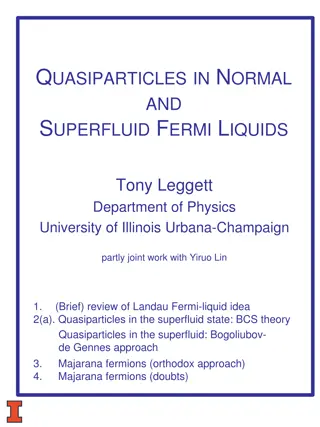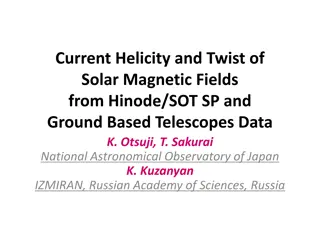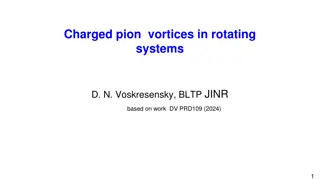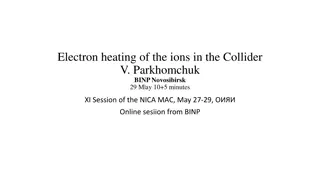Superfluid Vortices and Magnetic Fields in Heavy-Ion Collisions
Investigate the impact of superfluid vortices and magnetic fields on the power spectrum of flow fluctuations in heavy-ion collisions. Explore topics such as flow fluctuation coefficients, vorticity detection, and magnetic field effects on flow dynamics. This study sheds light on initial fluctuations, baryon density phases, and the interplay between flow and magnetic fields.
Download Presentation

Please find below an Image/Link to download the presentation.
The content on the website is provided AS IS for your information and personal use only. It may not be sold, licensed, or shared on other websites without obtaining consent from the author.If you encounter any issues during the download, it is possible that the publisher has removed the file from their server.
You are allowed to download the files provided on this website for personal or commercial use, subject to the condition that they are used lawfully. All files are the property of their respective owners.
The content on the website is provided AS IS for your information and personal use only. It may not be sold, licensed, or shared on other websites without obtaining consent from the author.
E N D
Presentation Transcript
Effect of superfluid vortices and magnetic field on the power spectrum of flow fluctuations in heavy-ion collisions Ajit M. Srivastava Institute of Physics Bhubaneswar, India
Outline: Talk divided in three parts 1. Power spectrum of flow fluctuation coefficients vn: Valuable probe for initial fluctuations: like CMBR power spectrum. Hydrodynamics simulations: Non-trivial structure of flow power spectrum, information about freezeout horizon, viscosity, .. 2. Probing high baryon density phases through vorticity detection CFL phase, nucleon superfluidity (as in pulsar glitches): All lead to superfluid vortices. Qualitative effectson flow power spectrum. New focus for FAIR and NICA: very low energy collisions with neutron rich nuclei to get nucleon superfluidity Possibility of probing pulsar vortices in heavy-ion collisions 3. Magnetic fields and Flow fluctuations: A. Effect of magnetic field on Flow: Enhancement of elliptic flow, ( /s larger than AdS/CFT limit?), power difference in even-odd vn Magnetohydrodynamics simulations B. Effect of flow on magnetic field: Enhancement of magnetic field. Recent work: Flux re-alignment, Dynamo effect from vorticity
Part 1: Power spectrum of Flow fluctuations: Recall: Elliptic Flow: QGP region anisotropic in non-central collisions collision along z axis Collision region y central pressure = P0 Outside P = 0 x z P P Spectators Anisotropic shape implies: x y Important: Initially no transverse expansion Anisotropic pressure gradient implies: Buildup of plasma flow larger in x direction than in y direction
y Initial particle momentum distribution isotropic : it develops anisotropy due to larger flow in x direction x This momentum anisotropy is characterized by the 2nd Fourier coefficient V2 (Elliptic flow) Note: Elliptic flow strong evidence for thermalization. No other way To get anisotropic momentum distribution only from spatial anisotropy. Led to very important results: Strong constraints on /s : values determined to be in range 1 -3 times AdS/CFT bound. Lower than any known liquid. Long realized that initial fluctuations affect determination of event Plane and initial eccentricity. Earlier discussions mostly focused on a couple of Fourier coefficients, Vn with n = 2, 4, 6, 8 (Note: no odd harmonics)
Power spectrum of flow fluctuations: New approach to flow analysis Mishra, Mohapatra, Saumia, AMS: PRC 77, 064902 (2008); 81, 034893 (2010) Inhomogeneities of all scales present, even in central collisions: Arising from initial state fluctuations These anisotropies were known earlier, however, they were only discussed in the context of determination of the eccentricity for elliptic flow calculations. We argued that due to these initial state fluctuations all flow coefficients will be non-zero in general: All Fourier coefficients Vn are of interest (say, n=1 to 30 -40, including Odd harmonics, these were never discussed earlier, For example, triangular flow is discussed now only as arising from Initial state fluctuations. We emphasized: Learn from CMBR power spectrum analysis: Calculate root-mean-square values of Vn , and NOT their average values.
Initial state fluctuations transverse energy density: Au-Au central collision at 200 GeV/A, HIJING (Blaizot s talk, Matter at extreme conditions, 2014) Thus: the equilibrated matter will also have azimuthal anisotropies (as well as radial fluctuations) of similar level.
Important lesson for heavy-ion collisions from CMBR analysis CMBR temperature anisotropies analyzed using Spherical Harmonics T = ( , ) ( , ) lmY a lm T Now: Average values of these expansions coefficients are zero due to overall isotropy of the universe = 0 a lm However: their standard deviations are non-zero and contain crucial information. = 2| | C a l lm This gives the celebrated Power Spectrum of CMBR anisotropies Lesson : Apply same technique for RHICE also
For central events average values of flow coefficients will be zero 0 = n V (same is true even for non-central events if a coordinate frame with fixed orientation in laboratory system is used). Following CMBR analysis,we proposed to calculate root-mean-square values of these flow coefficients using a lab fixed coordinate system, And plot it for a large range of values of n = 1, 30-40 = 2 rms n V V n These values will be generally non-zero for even very large n and will carry important information
Recall: Acoustic peaks in CMBR anisotropy power spectrum Solid curve: Prediction from inflation rms n V Can such a power spectrum be plotted for heavy-ion collisions ? So far we discussed: Plot of Vnrms for large values of n will give important information about initial density fluctuations. We now discuss: Such a plot may also reveal non-trivial structure like acoustic peaks for CMBR as above.
References : The suggestion to plot this power spectrum for relativistic Heavy-ion collision experiments was first given by us (Mishra, Mohapatra, Saumia, AMS) in the following papers : 1) Super-horizon fluctuations and acoustic oscillations in relativistic heavy-ion collisions: PRC 77, 064902 (2008) 2) Using CMBR analysis tools for flow anisotropies in relativistic heavy-ion collisions: PRC 81, 034903 (2010) It was emphasized in these papers that such a plot will have Valuable information about nature of fluctuations, especially initial fluctuations, and will be non-trivial for all n (up to about 30, including odd n). This applies to all collisions, including central collisions.
An Important feature of flow power spectrum Fluctuations with superhorizon wavelengths Meaning of Horizon for the Universe: Horizon size = speed of light c X age of the universe t No physical effect possible for distances larger than this In the universe, density fluctuations with wavelengths of superhorizon scale have their origin in the inflationary period. Tiny fluctuations are stretched by superluminal expansion Meaning of Horizon for Heavy-ion collisions: System equilibrates in time less than 1 fm/c. Horizon size = c No physical effects possible for distances larger than c = 1 fm. Note: Fluctuations present of all wavelengths even at time (arising from N-N collisions and fluctuations in nucleon positions). All fluctuations larger than 1 fm are superhorizon at time . At any later time , any fluctuation larger than c is superhorizon.
We argued that sub-horizon fluctuations in heavy-ion collisions should display oscillatory behavior just as fluctuations for CMBR What about super-horizon fluctuations ? Recall: For CMBR, the importance of horizon entering is for the growth of fluctuations due to gravity. This leads to increase in the amplitude of density fluctuations, with subsequent oscillatory evolution, leaving the imprints of these important features in terms of acoustic peaks. Superhorizon fluctuations for universe do not oscillate (are frozen, as we discussed earlier). Importantly, they also do not grow, That is: they are suppressed compared to the fluctuation which enters the horizon.
For heavy-ion collisions, there is a similar (though not the same, due to absence of gravity here) importance of horizon entering. One can argue that flow anisotropies for superhorizon fluctuations in heavy-ion collisions should be suppressed by a factor where Hs freezeout time tfr (~ 5-10 fm for heavy-ion collisions) Hs fr fr is the sound horizon at the / 2 This is because here spatial variations of density are not directly detected, in contrast to the Universe where one directly detects the spatial density fluctuations in terms of angular variations of CMBR. For heavy-ion collisions, spatial fluctuation of a given scale (i.e. a definite mode) has to convert to fluid momentum anisotropy of the corresponding angular scale. This will get imprinted on the final hadrons and will be experimentally measured. This conversion of spatial anisotropy to Momentum ansitropy (via pressure gradients) is not effective for Superhorizon modes. Thus: Superhorizon modes will be suppressed in heavy-ion collisions
Results: (modeling only, no hydrodynamical simulation here yet) HIJING parton distribution Errors less than ~ 2% uniform distribution of partons Include superhorizon suppression Include oscillatory factor also Note: Dissipation, e.g. from viscosity, diffusion, will damp higher n modes
Paul Sorensen Searching for Superhorizon Fluctuations in Heavy-Ion Collisions , nucl-ex/0808.0503 See, also, youtube video by Sorensen from STAR: http://www.youtube.com/watch?v=jF8QO3Cou-Q
Focus on dip for low n below First peak 1st peak at n = 3 2nd peak at n = 9 1st dip At n = 7 1st peak at n = 5 2nd peak at n = 9 1st dip at n = 7
arXiv: 1107.1468, LHC Pb-Pb at 2.76 TeV Note: Very important to understand suppression of low n harmonics It contains the information about freezeout horizon size
Relativistic Hydrodynamics Simulations: (Saumia P.S., AMS, arXiv: 1512.02136, Mod. Phys. Lett. A, Oct. 2016) We have developed two independent codes for hydrodynamic simulation for heavy-ion collisions. We compare the results of both Simulations and cross-check for consistency. One simulation is 3-D simulation with random Gaussian fluctuations of specific width on a Woods-Saxon background corresponding to QGP with initial temperature of 500 MeV. Power spectrum are obtained for the central rapidity region. Second one is a 2-D simulation with Bjorken scaling model. Initial density profile is obtained from Glauber initial conditions for Pb-Pb collision at 200 GeV energy. We study power spectrum of spatial anisotropies, momentum anisotropies, time evolution of power spectrum and the peak structure in the power spectrum. Our results show startling correspondence with evolution of fluctuations in the universe and CMBR power spectrum, in complete agreement with our earlier predictions.
Changes in the location of peaks with energy-matter density of the Universe, (apparent horizon size changes)
Results of the simulation: Plots of Vnrms vs. n for Gaussian fluctuations of width s Note: Here peak position gives information about length scale of fluctuations Blue plot: s = 0.4 fm Red plot: s = 0.8 fm Green plot: s = 1.6 fm Just as for CMBR, where first peak location directly gives size of largest fluctuation at last scattering surface Woods-Saxon density profile, 2 fm radius with 10 Gaussian fluctuations, To=500 MeV
Evidence for Superhorizon suppression Superhorizon suppression Power spectrum of momentum anisotropies Power spectrum of spatial anisotropies Conclusions for Part 1: Power spectrum of flow fluctuations is a valuable probe for fluctuations and their evolution in heavy-ion collisions: Just like CMBR power spectrum in the universe
Part 2: Probing high baryon density phases through vorticity detection (Arpan Das, Shreyansh Dave, Somnath De, AMS, arXiv: 1607.00480) Recall: QCD Phase diagram High density transition to exotic phases: superfluidity: Vortices ? Note: Possibility of Nucleon superfluidity for low energy collisions ? Qualitative effects on the power spectrum, clean signal of vorticities.
Different phases at high baryon density: At ultra-high baryon density very large chemical potential. asymptotic freedom makes Perturbative calculations reliable. One-gluon exchange: quark-quark interaction attractive in 3* channel Cooper problem: Any attractive interaction destabilizes Fermi surface BCS pairing of quarks in 3* channel: Color Superconductivity Quark Cooper pair: , color, i,j, flavor, a,b spin Consider most symmetric case: all three flavors masssless (not unreasonable for very high chemical potential)
Color-Flavor Locked (CFL) phase: color antisymmetric, spin antisymmetric, flavor antisymmetric: pairing pattern: Note: This is invariant under equal and opposite rotations of color and (vector) flavor: Leads to following spontaneous symmetry breaking Color SU(3) spontaneously broken Other possible pairings: 2 light flavors: 2SC pairing Breaks Color SU(3) to color SU(2) symmetry.
Topological properties of the CFL phase: CFL spontaneous symmetry breaking pattern: Check: Homotopy groups of the vacuum manifold So: No domain wall, or monopole defects String defects: superfluid vortices Doubling of colored Skyrmions (baryons)
Implications of the Topological Analysis: Universality implies that: Transition to CFL phase will invariably lead to formation of suerfluid vortices: These will lead to strong fluid circulation right from the initial stage of transition: It is obvious that resulting flow pattern will be dramatically different from the case without any vortex. Thus: Qualitative changes in the flow pattern, specifically the flow power spectrum can give clean signal of transition to these Exotic phases of QCD. Important to note: Nucleon superfluidity is believed to exist in the interiors of neutron stars. Strong support from pulsar glitches
Superfluid phase of neutron star: Observations: Pulsars are rapidly Rotating neutron stars, detected by their periodic pulses (electromagnetic waves), Beamed emission from the magnetic poles of the neutron star. Superfluid phase in the interior allows for vortex lattice to form. Vortices are pinned at the interface with crust. Superfluid vortices play fundamental role in determining rotational properties of neutrons star, hence pulsar timings. Phenomenon of glitches explained by vortex depinning from crust. Sudden transfer of angular moment from superfluid to outer crust Leads to glitches in pulsar timing.
(from Internet) Inner Core: Size ~ 1 Km QCD phases: QGP, CFL, etc. 0.2 km 1 km 9 km 1 km Outer Core: Size ~ 9 Km Superfluid Phases of Nucleons Superfluid Vortices play Important role in glitches
Inner Crust region: Superfluid 1S0 phase appears in the inner crust region: Extending from x 1011 g/cm3 to 2 x 1014g/cm3 For the 3P2 channel, the interaction becomes strongly attractive only at higher density, this occurs in the core of the neutron star. This phase is quite like the superlfuid phase of 3He Allows for non-trivial order parameter, and hence associated topological defects. Even though nucleon superfluid vortices play crucial role in understanding of pulsar glitches, Only theoretically investigated so far Thee have never been seen in any experiment.
Proposal: Very low energy collisions of neutron rich nuclei (possibly superheavy, near neutron dripline) may create bulk phase of nucleon superfluidity. Possible at FAIR and NICA This is a suggestion for another direction: Surely QGP search is very exciting and novel: But so is the search for the superfluid phase of nucleons, and the associated vortices which are believed to play crucial role in pulsar dynamics Our signals can detect nucleon superfluid vortices and investigate their properties under direct experimental control. Very important for understanding of neutron star properties. Nucleon superfluid transition temperautre: 0.2 MeV to 5 MeV Density is nuclear saturation density Such temperatures/densities are within reach at FAIR and NICA:
Collisions of Au on Au with the FOPI-facility at GSI Darmstadt. E/A 150 250 400 MeV/A (incident) T 17.2 3.4 26.2 5.1 36.7 7.5 MeV (results from blast model fit) Freezeout density = 0.4 x nuclear saturation density nucl-ex/9610009 Intermediate mass fragments z>2 Au-Au collisions at E/A = 50, 100, 150, and 200 MeV, at heavy-ion synchrotron SIS, T ~ 4-5 MeV is reached (nucl-ex/9801006) Lower energy collisions or, a more dilute system quite likely to give lower T and correct for superfluid transition UrQMD simulations in Progress.
Properties of CFL vortices: Correlation length: Velocity profile: For r < For r > Results shown for Tc = 50 MeV, q = 500 MeV, T = 25 MeV Resulting = 0.7 fm, v0 = 0.3 Same velocity profile holds for nucleon superfluid vortices, For that case, Tc = 0.3-5 MeV, fm
Results of relativistic hydrodynamics simulations with two-fluid picture of superfluid (normal component and superfluid component) Qualitatively different features of flow pattern and power spectrum Signalling superfluid transition Velocity profile at central rapidity without (left) and With (right) vortices: = 0.84 fm/c
Power spectrum at t-t0 = 1.68 fm for central collision. Different plots show the power spectrum for the cases of no vortex, single vortex, a V-V pair, and a V-AV pair. Recall: for central collisions we expect very small elliptic flow Inset shows dependence of elliptic flow at different times on the superfluid fraction for the V-AV case showing very large initial elliptic flow.
Time evolution of the power spectrum for the case with a V-V pair showing the difference in the power for even and odd Fourier coefficients for early times. Could be probed by thermal photon elliptic flow, or peripheral collisions.
Plot of v2and v4for non-central collisions for a Vortex-Anti-vortex pair along z axis, and a single vortex along the x axis, showing negative elliptic flow at initial stages as well as large (negative) values of v4 Conclusions for Part 2: Superfluid vortices can be detected using flow power spectrum: FAIR and NICA can probe pulsar vortices using very low energy collisions: Focused effort needed
Part 3: Magnetic field and flow fluctuations: A: Effect of Magnetic Field on plasma waves, hence on flow: A conducting plasma in the presence of magnetic field will evolve according to the equations of magnetohydrodynamics. In presence of magnetic field, there are three types of waves in the plasma in place of ordinary sound waves. Fast magnetosonic waves: Generalised sound waves with significant contributions from the magnetic pressure. Their velocity is given by c2+~c2s + v2Asin2 where is the angle between the magnetic field B0 and the wave vector and the Alfven velocity vA=B0/ 4 Slow magnetoacoustic waves: Sound waves with strong magnetic guidance. c2-=v2Acos2 Alfven waves: Propagation of magnetic field perturbations.
B n vgr x t Note: Direction of group velocity depends on the coefficient of t above, which depends on local pressure (for a given B). Thus: with pressure variations, direction keeps changing, Thus: Complex flow pattern even with radial expansion
Our earlier work: R.K.Mohapatra, P.S. Saumia, AMS, MPLA26, 2477 (2011). The effect of magnetic field on vn was modeled as follows: (For elliptic flow we know that v2 / cs ) Generate initial density fluctuations from HIJING Calculate Fn (the Fourier coefficients of spatial anisotropy) vn is calculated from Fn , now as proportional to group velocity which in turn is a function of the azimuthal angle. B n vgr Magnetic field B is taken to be proportional to the impact parameter b, x with maximum value B = 1015 Tesla at b = 10 fm. t
Magnetic field along Y axis: Flow along X axis deforms magnetic field: higher Energy cost compared to flow along Y axis Equation of state becomes anisotropic: Speed of sound larger along x axis compared to y axis Flow from initial spatial anisotropy is proportional to sound speed Thus: Flow along X axis becomes larger than along Y axis: This enhances elliptic flow. Can this accommodate larger values of viscosity ? Note: If magnetic field points along X axis? This should suppress elliptic flow. We confirmed this using magnetohydrodynamics simulations Possible to achieve using deformed nucleus (U on U)
Enhancement of elliptic flow v2 with magnetic field (up to 30 %) R.K.Mohapatra, P.S. Saumia, AMS, MPLA26, 2477 (2011). B ~ 0.5 b m (fm) B/m = Subsequent analysis by Tuchin: Results in agreement with this K. Tuchin, J.Phys. G 39, 025010 (2012)
Relativistic Magneto-Hydrodynamics Simulations: (Arpan Das, Shreyansh Dave, Saumia Pandiat, AMS) Equations of relativistic MHD: (follow formalism from: Mignone and Bodo, Mon. Not. R. Astron. Soc. (2005) + + + + = 2 2 [{( ) | | )} ( | | ) 2 / ] 0 P b u u b b P b g g = ( ) 0 u b u b V B B V V B = + 2 [ . , / ( . )] b We solve these equations using Leapfrog algorithm of second order. For large velocities, accuracy not enough, so Keep evolution for short times and for small gradients. Initial Conditions: Distribution of energy density, magnetic Field, velocities (taken to be zero) Equation of state: relativistic ideal gas, given T,
Enhancement of elliptic flow v2 with magnetic field Prediction based on magnetosonic waves: Using HIJING for Au-Au at 200 GeV Results of present MHD simulation: For T = 130 MeV, q = 500 MeV v2(B)/v2(0) v2(B)/v2(0) (fm) B/m = R.K.Mohapatra, P.S. Saumia, AMS, MPLA26, 2477 (2011). B/m A.Das, S. Dave, Saumia P.S., AMS Can this accommodate larger values of s ?
B = 0.01,5,10 m2, t = 1.3 fm, with fluctuations Plots of Vn(rms) vs. n - Full Power spectrum
By = 0.01,5,10,20 m2, t = 1.3 fm, with fluctuations Plots of Vn(rms) vs. n - Full Power spectrum Note: marked suppression of odd harmonics for large B: Distinctive Signal for presence of strong magnetic field at early times
Part 3B: Magnetic field enhancement from flow (Arpan Das, Shreyansh Dave, Saumia Pandiat, AMS) Magnetic field realignment due to density fluctuations: Initial Increase in B, before it decreases due to expansion with density fluctuations B/B0 without density fluctuations
Dynamo effect at play in Heavy-ion collisions: Huge enhancement in magnetic field due to plasma Turbulence (from vortices): Flow energy feeds growth of B with fluctuations, and a Vortex-antivortex pair B/B0 With fluctuations, no vortices no fluctuations, no vortices
Dynamo effect: Cont. B/B0 with fluctuations, and vortex Conclusions for Part 3B: Vortices possible at high baryon density (at FAIR and NICA). These can lead to Dynamo effect and amplify initial magnetic field
Conclusions: 1) Power spectrum of flow fluctuations : Important tool for probing initial fluctuations and their evolution 2) Qualitative changes in power spectrum in presence of superfluid vortices: clean signal for CFL, nucleon superfuid phases Important for understanding pulsar dynamics: Focused effort needed at FAIR and NICA for collisions at very low energies. 3) A: Magnetic field can strongly affect plasma evolution. Enhancement of elliptic flow Suppression of elliptic flow for deformed nuclei (in some cases) B: Flow energy can feed into magnetic field: Dynamo effect especially strong with vortices: possible at high baryon density as at FAIR and NICA (vortices unlikely at LHC)
Thanks Organizers For a great conference
